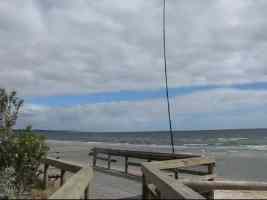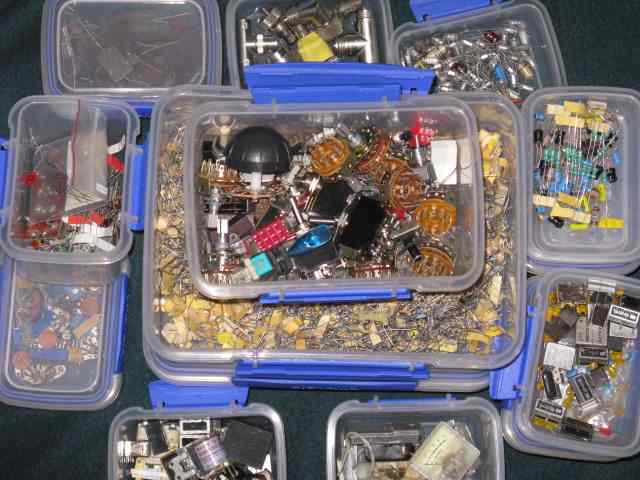Radio hints and tips

This item is a selection of hints and tips that I trust will be found useful around the shack and workshop.
Vertical dipoles from coax cable
With
a Stanley knife make a cut around the coaxial feedline approximately one
quarter wavelength from the end of the cable (length in metres =
71.5/frequency). Then slit the cable to remove the outer jacket
from the cut to the end of the cable. With a small screwdriver make a
hole in the braid near the start of the outer jacket. With
the screwdriver, lever the inner conductor out through the hole. Solder
an eye terminal or washer to the end of the inner conductor to provide a
support for hanging from a tree branch or curtain rail.
Uses for scrap circuit board material
These
include small boxes, dividers where shielding is important, small nameplates
(if etched) and square pads for 'paddyboard' construction. For the
latter, tin snips or multipurpose shears will cut the material nicely.
Soldering two wires together without an iron
Wrap
join with solder. Then wrap with aluminium foil. Hold a lighted
match to joint until solder melts. Remove foil when solder sets.
Illuminated dummy load
A
12-volt 300mA light globe soldered into a PL259 plug makes a useful dummy load
for HF QRP equipment running up to a few watts.
Cutting ferrite rods to size
Saw
groove around rod with hacksaw. Hold rod in two hands and apply force.
The
rod should snap cleanly.
Determining loss of coil formers for
antenna traps, etc
Place
material in microwave oven with glass of water. High loss material
will get very hot or melt. Material that stays cold or warms only
slightly is suitable for use. Remember to remove all metal traces (eg
wire or mounting screws) before doing the test!
Portable antenna mast
An
eight or nine metre giant squid pole forms an excellent mast for portable
operation. These lightweight poles (also called roach poles or telescopic
poles) are available from fishing shops and collapse down to about 1.1
metres. Squid poles can support lightweight wire antennas for HF and
VHF/UHF groundplanes. The poles will not support coaxial
feedline unless it is supported by taping it to the pole. Available from haverford.com.au.

Handheld antennas
Antennas
that a quarter wavelength or less on handheld transceivers often benefit from
the addition of a counterpoise. Clip a quarter wavelength of wire (that's 48cm on 2m and 16cm on 70cm) onto
the earth connection of the radio's antenna socket.
Holding nuts in tight places
1.
Blu-tac or small dab of glue on end of screwdriver
2.
Rubber band across handles of long-nose pliers
Easy connectors
Terminal
blocks cut up into strips make handy barrel connectors.
Insulators for wire antennas
For
temporary portable antennas, use toothbrush handles. Otherwise use
sections of plastic conduit.
Pedestrian mobile HF station
A
case to hold a transceiver, gel battery and antenna can be made from pieces of
10mm-thick chipboard. Thread old coaxial cable through holes in the
box to make carry handles. To prevent rubbing against the operator if the
station is used whilst walking, glue carpet to the side of the box closest to
the operator. For the transceiver, use a converted CB for 10 metres or
Yaesu FT-817 for HF/VHF/UHF coverage.
Spreaders for open wire feedlines
If
you have a few more toothbrush handles, you can use them as spreaders in
home-made open wire feedline. Alternatives include hair curlers, or
my favourite, plastic irrigation tube about 6mm in diameter as sold by garden
suppliers.
Doing well in contests
If
you use a good antenna from a good location and consider yourself to be a
'strong station', spend most of your time calling CQ – others will find and
work you. If your signal is weaker than others, spend most time tuning
the band and calling other stations. Once all stations heard have been
worked, find a clear frequency and call CQ for a while.
Cheap VHF/UHF signal generator
An
HF rig fed into a dummy load makes a crude signal generator for doing tests on
VHF/UHF receivers or as a BFO for receiving SSB on an AM receiver. Set
the transceiver to just above 28.8 MHz for harmonics in the 144 and 432 MHz
bands.
Projecting sound forward from
top-mounted speakers
Transceivers
with top-mounted speakers can benefit from a yoghurt container (with a forward
facing cutout) placed over the speaker grille. The container projects the
sound forward towards the operator.
Improving access to station equipment
When
you next renovate the shack, consider placing the operating desk about a metre
from the wall. This will make it easier to access power and antenna
connections and add new equipment.
Labelling leads
Cables should be labelled
to minimise the risk of equipment damage, for example when transmitted power is
applied to the antenna socket of a receiver. A good way is to write (with
a ballpoint pen) labels onto strips of paper 5mm wide and as long as the label
requires. Clear adhesive tape is placed over the front of the label and around
the cable. The tape is then continued so that it sticks to the back of the
paper and around to the front of the label, where it is cut with scissors. The
result is a descriptive 'flag' at the end of the cable near the connector. A
refinement could be to write on both sides of the paper strip instead of one.
Antenna accessories at fishing shops
Apart
from squid poles (see previously) several other items useful to the amateur can
be procured at fishing shops. Fishing reels are ideal for storing wire
antennas. Depending on the length and thickness of the antenna wire,
diameters between 10 and 25 centimetres are suitable. Sinkers and fishing
line are also useful for raising antenna wires over tree branches.
Uses for octal valve bases and film
containers
Octal
valve bases glued to short section of pipe (or the old 35 mm film containers) form useful plug-in coils for
receivers, dip oscillators and antenna coupling units covering the low HF
bands. Octal plugs and bases are expensive from major parts outlets but often come up at hamfests. For coverage of higher frequencies, use 5-pin DIN plugs and
formers approximately 12mm in diameter, such as conduit.
Use for old coax
Lossy
or water-damaged coax can still be used for ground radials. The braid can also
be used for earth connections.
Storing parts
Transparent food containers, especially those with clip-on lids, are great for storing small parts or hardware.

Calling on repeaters
When
putting out a call, press the PTT button, wait 5 seconds and then call. This
gives time for people's scanning transceivers to stop on your frequency, for
your call to be heard and increases the chance of getting a response.
On indicator
To
add an on indicator for projects that operate from 12 volts, wire an LED in
series with a 560 ohm resistor.
Polarity
protected projects
Simply
wire the positive and negative power leads to the positive and negative
connections of a diode bridge rectifier. The polarity applied to the two
AC inputs is not critical. This technique is only recommended for
low-powered projects with plastic or non-earthed metal cases and in situations
where the voltage drop across the bridge will not impair operation.
BFO for SSB
Cheap
one or two band shortwave receivers seldom have a beat frequency oscillator
required for amateur SSB reception. A portable AM broadcast radio placed
near the receiver can be used as a BFO, with no connections required.
Setting the radio near 1.3 MHz should cause a carrier to be heard near 3.5 MHz
or 7 MHz. To use, tune for maximum 'duck talk', and carefully adjust the
broadcast receiver until the signal becomes intelligible. Move the
receivers closer together for strong signals and further apart for weak
signals. It's fiddly, but it works!
Estimating thickness of enamelled wire
Wind
10 turns onto a pencil, measure in millimetres with a ruler and divide result
by ten.
Tuning indicator for base loaded HF
antennas
Attach
one side of a neon bulb to the top of the loading coil. Leave the other
side of the bulb floating. Use 5-10 watts and aim for maximum brightness.
Use for computer power supplies
Many
articles have described how two disused computer power supplies can be made
into a high-current 13.8 volt supply for transceivers, etc. Not all
constructors have found this project straightforward, and only competent
builders should attempt it. However if you are willing to accept a
reduced voltage (11.5 to 12 volts) and reduced current (up to a few amps), the
12-volt output from a single, unmodified supply will adequately power CB and
low power amateur equipment.
Using small bits in large drill chucks
Wrap
a few turns of solder around the bit, insert in chuck and tighten. The
technique can also be used to salvage drill bits that have been broken.
Preventing components being lost
When
assembling kits or constructional projects, place the parts in a shallow dish
to prevent them rolling off the table or bench.
SO239 antenna mount
A
square-type SO239 chassis mount socket makes a handy base for quarter wave
ground plane antennas for two metres or seventy centimetres. The feedline
can be fed up a tube (with an inside diameter larger than the PL259 diameter)
or taped to a squid pole for a quick home station antenna.
Emergency supply of solder
Wrap
solder around cord of soldering iron to form emergency supply of solder to use
when your reel runs out.
Quick six metre antenna
It's
worth a reminder that a 5/8 wavelength whip for two metres will operate
effectively on six metres as a ¼ wavelength whip.
Cases from component stereo systems
1970s
stereo equipment is now available cheaply from garage sales and car boot
sales. The boxes from amplifiers, tape decks, graphic equalisers make
fine enclosures for large projects, such as homebrew transceivers, antenna
couplers and power supplies. Use printed circuit board scraps to cover
holes if necessary.
Disclosure: I receive a small commission from items purchased through links on this site.
Items were chosen for likely usefulness and a satisfaction rating of 4/5 or better.
An earlier version of this article appeared in Amateur Radio June 2001 with updates made since.
|


